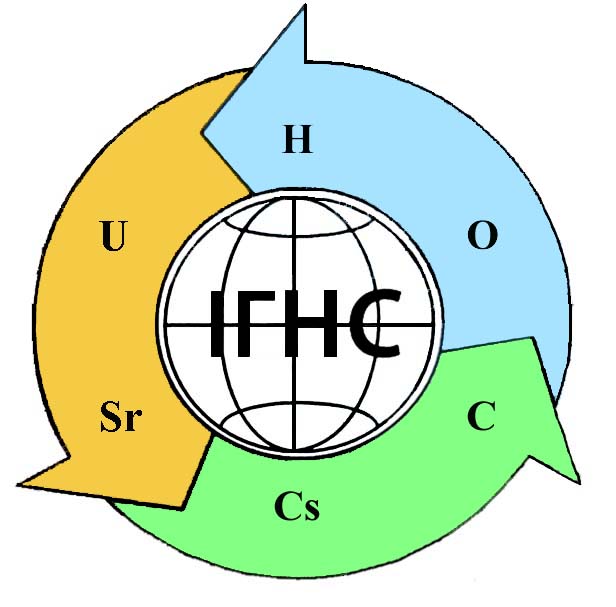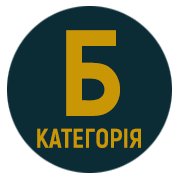REGULARITIES OF 137CS MIGRATION ON GEOCHEMICAL BARRIERS OF MARGINAL ZONE OF MEZOTROPHIC BOG IN UKRAINIAN POLISSYA
DOI:
https://doi.org/10.15407/geotech2021.34.058Keywords:
biogeochemical barrier, transsuperaquatic landscape, biogeocenosis, 137Cs, soil, layers of vegetation, intensity of 137Cs accumulation.Abstract
It was shown that in the narrow marginal zone (about 6-8 m wide) of a mezotrophic bog, typical for the northern part of Ukrainian Polissya, a transsuperaquatic landscape is formed between transacumulative and superaquatic landscapes. In the transsuperaquatic landscape a complex biogeochemical barrier has been formed. Here, at a short distance, barriers of different types are spatially connected – physico-chemical (sorption, gley etc.) and phytocenotic (all vegetation layers), lateral and radial. It was found that due to lateral 137Cs redistribution among the geochemically connected landscapes of the catena, there was observed the concentration of the radionuclide on the investigated complex biogeochemical barrier. Three biogeochemical barriers were found in the soil – layers of semi-decomposed residuals of mosses, trees and grasses (H0dt), peat (Т1-Т5) and iluvial humic-ferruginous gley horizon (Ihgl), which slow down 137Cs migration both in lateral and radial directions. Generalization of datа on 137Cs radial distribution in the soil of the geochemical barrier shows that analogs of the forest litter (H0 non-decomposed and layer of H0dt – semi-decomposed plant residuals) contained 8.16% of the total 137Cs activity in the soil; peat (0-25 cm) – 17.14%, and the mineral horizons (Ihgl and Pigl) – 74.7%. This distribution testifies about high speed of radial 137Cs migration in the studied soil, insofar as the main part of the total activity of 137Cs has already migrated beyond the boundaries of the peat layers to the mineral horizons. The calculations showed that the main part of the total stock of 137Cs in biogeocenosis on the biogeochemical barrier in the transsuperaquatic landscape was retained in soil – 86.59%, accordingly phytocenosis contained 13.41% of the total stock of the radionuclide. The geochemical transfer coefficient was 0.16, which was close to the corresponding values for the superaquatic landscapes. Significant interspecific differences in 137Cs accumulation were observed in all layers of vegetation. The migration ability of 137Cs in the chains «soil – plant» and «soil – fungi» in the transsuperaquatic landscape was evaluated based on the mean 137Cs transfer factor (TF) values to be 2-20 times higher than that for the eluvial and transeluvial landscapes. This leads to significant excess of the permissible levels of the 137Cs specific activity in medicinal plants, wild berries and edible mushrooms at soil contamination density with 137Cs which is not officially regarded as radiationally hazardous (about two times less than 37 kBq·m-2).
References
Авессаломова И.А. Геохимические показатели при изучении ландшафтов: Учеб.-метод. пособие. М.: Изд-во Моск. ун-та. 1987. 108 с. 2. Глазовская М.А. Геохимические основы типологии и методики исследований природных ландшафтов. М.: Изд-во Моск. ун-та. 1964. 229 с.
Долін В.В. Самоочищення наземних екосистем Українського Полісся від радіаційного забруднення: Автореф. дис. … доктора геол. наук. Київ, 2004. 36 с.
Короткова О.З. Накопичення 137Cs основними дикорослими ягідими рослинами лісів Українського Полісся: Автореф. дис. ... канд. сільськогосп. наук. Житомир. 2000. 19 с.
Ландшафты Чернобыльской зоны и их оценка по условиям миграции радионуклидов. Давыдчук В.С., Зарудная Р.Ф., Михели С.В., Петров М.Ф., Сорокина Л.Ю., Ткаченко А.Н. Под ред. А.М. Маринича. К.: Наук. думка. 1994. 112 с.
Молчанова И.В., Караваева Е.Н., Куликов Н.В. Радиоэкологическое изучение почвенно-растительного покрова сопряженных участков ландшафта в зоне Чернобыльской АЭС. Экология. 1990. № 3. С. 30-35.
Орлов О.О., Долін В.В. Біогеохімія цезію-137 у лісоболотних екосистемах Українського Полісся. К.: Наук. думка, 2010. 198 с.
Павлоцкая Ф.И., Тюрюканова Э.Б. Миграция искусственных радионуклидов в природных биогеоценозах. Проблемы радиоэкологии и биологического действия малых доз ионизирующей радиации. Сыктывкар: Коми-филиал АН СССР. 1976. С. 30-45.
Перельман А.И. Геохимия ландшафта. М.: Высш. шк., 1975. 342 с.
Перельман А.И. Геохимия. М.: Высш. шк., 1989. 528 с.
Перельман А.И., Борисенко Е.Н. , Воробьев А.Е. и др. Систематика и картографирование геохимических ландшафтов при решении геоэкологических задач. Междунар. симп. по прикладной геохимии стран СНГ: Тез. докл. Москва. 1997. С. 137.
Родин Л.Е., Ремезов Н.П., Базилевич Н.И. Методические указания к изучению динамики и биологического круговорота в фитоценозах. Л.: Наука, 1968. 145 с.
Страх Л.И. Геохимические барьеры краевой зоны болота Белорусского Полесья и концентрация на них 137Cs: Автореф. дис. ... канд. геогр. наук. – М.: МГУ. 1999. 24 с.
Страх Л.И., Кнатько В.А. Концентрация цезия-137 на биогеохимическом барьере краевой зоны болота Белорусского Полесья. Весцi АН Беларуси. Сер. хим. наук. 1997. № 3. С.77-82.
Страх Л.И., Кнатько В.А. Распределение цезия-137 и других химических элементов на физико-химических барьерах краевой зоны болота Белорусского Полесья. Весцi АН Беларуси. Сер. хим.наук. 1997. № 1. С.79-84.
Тюрюканова Э.Б. О биогеохимических циклах радионуклидов. Современные задачи и проблемы биогеохимии. Вып. 17. Москва, 1979. С. 143-150.
Юнатов А.А. Заложение экологических профилей и пробных площадей. Полевая геоботаника. Под общ. ред. Е.М. Лавренко и А.А Корчагина. Т. IIІ. М.-Л.: Наука, 1964. С. 9-35.
Modelling and study of the mechanisms of the transfer of radioactive material from terrestrial ecosystems to and in water bodies around Chernobyl. ECP-3 Final Report. Eds. U. Sansone and O. Voitsekhovitch. Luxembourg. 1996. 230 p.









